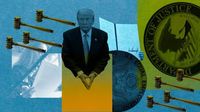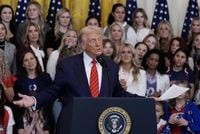The U.S. Department of Education has emerged as an aggressive enforcer of President Donald Trump’s social agenda, moving quickly and publicly to investigate school districts, colleges and universities, state education departments, and athletic associations while threatening their federal funding. As of March 27, 2025, the Education Department has opened at least 84 investigations aligned with core Trump policy objectives since the president took office, according to an EdWeek analysis of department announcements and local news reports.
The Trump administration has initiated most of these investigations on its own, rather than in response to complaints it has received. Most of the investigations announced have targeted universities’ diversity, equity, and inclusion initiatives, which Trump has cracked down on through executive action. The Education Department issued a February memo in which it told schools to end any race-based programming or risk losing federal funds.
School district, university, and state policies on transgender students have been the second most common subject of Education Department investigations. Trump has threatened to pull federal dollars from schools that don’t comply with his executive order barring transgender girls from girls’ sports teams, and he has also made it official U.S. policy to recognize only two sexes. Antisemitic harassment has been the third most common subject of Trump administration investigations.
Meanwhile, as the Education Department’s main investigative arm, its office for civil rights, ramps up enforcement of the president’s agenda, it has faced deep cuts in the department’s downsizing. Seven of its 12 regional offices were shuttered in March, and more than 40 percent of its staff were cut either through layoffs or buyout offers. Experts have said this will increase the remaining investigators’ caseloads, likely leading to an uneven focus on cases that align with the president’s agenda.
The office for civil rights is responsible for investigating discrimination claims and working with schools to comply with federal civil rights laws. The office typically opens investigations in response to claims it receives from students, parents, school staff, and community members. OCR has always been able to open investigations on its own—known as directed investigations—but previous administrations have used this tactic less often than the Trump administration appears to be using it, experts have told Education Week.
Amid the new administration’s policy changes, longstanding corporate DEI efforts are now considered ‘illegal.’ In January 2025, President Trump signed an executive order that aimed to clamp down on what he calls “illegal” policies on diversity, equity, and inclusion in the corporate world. The order steered federal agencies to “combat” private companies’ use of “DEI preferences, mandates, policies, programs, and activities,” according to legal industry news site JDSupra.
While the words from the White House included some aggressive language, the order was light on detail, specifically what actually constitutes “illegal” DEI under that order. The Equal Employment Opportunity Commission (EEOC) and the Department of Justice have now stepped up to fill this information void, issuing guidance to private sector employers about the policies they may previously have embraced that they should now avoid.
One of the key documents, JDSupra notes, is from the EEOC and it’s called “What To Do If You Experience Discrimination Related to DEI at Work.” Once you’ve got past the puzzling syntax of the title, there’s useful data in the text, though there’s no specific definition of what constitutes DEI. Instead, it includes guidelines for what habits might violate Title VII of the Civil Rights Act of 1964—i.e., discrimination—under the new Trump administration.
This includes using “quotas” or similar “balancing” tactics to diversify your workforce on the grounds of race, sex, or other “protected” characteristics. Your company also cannot use protected characteristics to make decisions for firing, hiring, promotion, or other typical business practices like deciding on pay. Among a list of other prohibited tactics, the document makes it clear that if you retaliate against a worker who states a “fact specific” complaint that your company is violating Title VII via a DEI policy, that’s a very bad thing.
The second important new document is called “What You Should Know About DEI-Related Discrimination at Work,” and it’s more of a “frequently asked questions” piece. Several of its statements are likely to spawn controversy. Those include defining the position of the EEOC to say there are no separate standards for “reverse discrimination,” meaning there’s no difference between discrimination experienced by an employee belonging to a majority group versus one belonging to a minority one.
Additionally, there is now only a need for a worker to demonstrate “some injury” or “some harm” to trigger a discrimination claim, versus the former, more strict, need to show “significant” harm. Whether this will cause an avalanche of discrimination lawsuits from aggrieved workers with discrimination complaints remains to be seen. Nevertheless, the EEOC and DOJ documentation may be an important resource for businesses large and small, arriving amid a barrage of reports that corporate America isn’t completely abandoning DEI.
Rather, some companies are “rebranding” their DEI policies, bending toward the new norm versus embracing it, and news that smaller businesses in particular are sticking by their guns. Steering between the new policy rules, the new EEOC and DOJ guidance (which JDSupra points out isn’t binding in court), and long-held corporate principles of equality and inclusiveness is likely to be tricky.
As at least one critic has pointed out, it may, or may not, be okay to merely change the language of existing corporate-level DEI rules. This complex landscape of shifting policies and enforcement highlights a significant moment for educational institutions and corporate America, as they navigate the evolving expectations of diversity, equity, and inclusion in an increasingly polarized environment.





